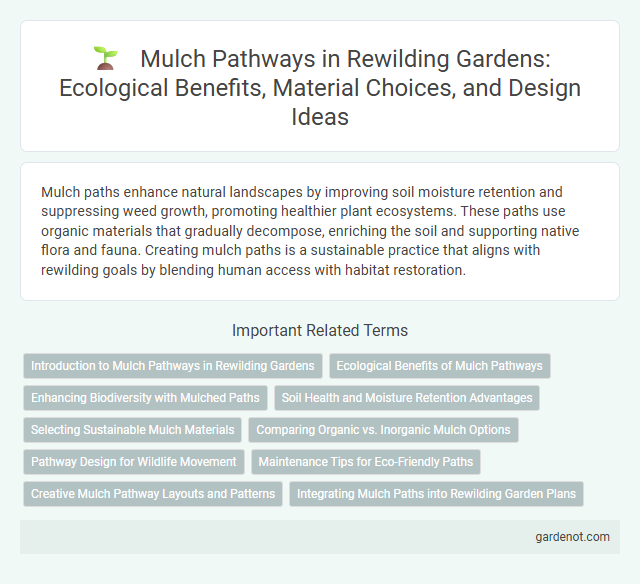Mulch paths enhance natural landscapes by improving soil moisture retention and suppressing weed growth, promoting healthier plant ecosystems. These paths use organic materials that gradually decompose, enriching the soil and supporting native flora and fauna. Creating mulch paths is a sustainable practice that aligns with rewilding goals by blending human access with habitat restoration.
Introduction to Mulch Pathways in Rewilding Gardens
Mulch pathways in rewilding gardens serve as sustainable, permeable surfaces that support natural water infiltration and reduce soil erosion. Composed of organic materials like wood chips, bark, or leaf litter, these paths enhance soil health by decomposing and returning nutrients to the ecosystem. Integrating mulch pathways encourages biodiversity by providing habitats for beneficial microorganisms, insects, and small wildlife within rewilded landscapes.
Ecological Benefits of Mulch Pathways
Mulch pathways significantly enhance soil health by retaining moisture and reducing erosion, which promotes robust plant growth and biodiversity. They create a natural habitat for beneficial microorganisms and insects, supporting ecosystem balance and pollination. By minimizing soil compaction, mulch paths improve water infiltration and nutrient cycling, crucial for sustainable rewilding efforts.
Enhancing Biodiversity with Mulched Paths
Mulched paths create natural corridors that support diverse plant and insect species by providing habitat and moisture retention. The organic mulch decomposes over time, enriching soil quality and fostering microbial activity crucial for ecosystem health. These paths reduce soil erosion and promote native vegetation growth, thus enhancing overall biodiversity within rewilded environments.
Soil Health and Moisture Retention Advantages
Mulch paths enhance soil health by promoting microbial activity and preventing erosion, resulting in richer, more fertile soil essential for rewilding projects. Their organic composition improves moisture retention, reducing water evaporation and maintaining consistent hydration levels crucial for native plant growth. These benefits create a sustainable environment that supports biodiversity and resilient ecosystems.
Selecting Sustainable Mulch Materials
Choosing sustainable mulch materials for mulch paths involves prioritizing organic options like shredded bark, wood chips, or leaf litter, which promote soil health and biodiversity in rewilding projects. Avoiding synthetic mulches reduces environmental impact and supports natural decomposition processes essential for ecosystem restoration. Selecting locally sourced materials minimizes carbon footprint and enhances the integration of paths within surrounding habitats.
Comparing Organic vs. Inorganic Mulch Options
Organic mulch paths use materials like wood chips, bark, and leaves, improving soil health by adding nutrients and supporting microbial activity, crucial for rewilding projects. Inorganic mulch options such as rubber, gravel, or plastic prevent weed growth and provide durability but lack nutrient contribution and biodegradability, potentially harming soil ecosystem function. Selecting mulch impacts soil moisture retention, temperature regulation, and habitat creation, making organic mulches preferable for restoring biodiversity and promoting ecological balance in rewilding landscapes.
Pathway Design for Wildlife Movement
Mulch paths in rewilding projects enhance natural habitat connectivity by providing soft, permeable surfaces that support diverse wildlife movement. These pathways minimize soil compaction and maintain moisture levels, fostering the growth of native vegetation crucial for shelter and foraging. Designing mulch paths strategically through corridors and buffer zones promotes safe animal crossings and encourages biodiversity within restored ecosystems.
Maintenance Tips for Eco-Friendly Paths
Mulch paths require regular replenishment of organic material to maintain a natural, weed-resistant surface that supports local biodiversity. Proper edging prevents mulch from spreading into adjacent areas, preserving path integrity and minimizing soil erosion. Periodic raking enhances drainage and prevents compaction, ensuring the path remains permeable and environmentally sustainable within rewilding projects.
Creative Mulch Pathway Layouts and Patterns
Creative mulch pathway layouts and patterns enhance the aesthetic appeal and ecological function of rewilding projects by guiding natural foot traffic while promoting soil health and moisture retention. Incorporating diverse shapes like spirals, labyrinths, or meandering curves increases habitat complexity and supports native plant growth by reducing soil compaction. Strategic placement of mulch pathways also aids in erosion control and delineates zones for rewilded flora, contributing to a dynamic and sustainable landscape design.
Integrating Mulch Paths into Rewilding Garden Plans
Mulch paths enhance rewilding garden plans by promoting soil health and supporting native biodiversity through natural decomposition processes. Incorporating organic mulch materials like wood chips or leaf litter stabilizes soil moisture and suppresses invasive weeds, fostering a thriving habitat for pollinators and soil microorganisms. These sustainable pathways seamlessly blend human accessibility with ecosystem restoration goals, maximizing habitat connectivity within rewilded spaces.
Mulch path Infographic

 gardenot.com
gardenot.com